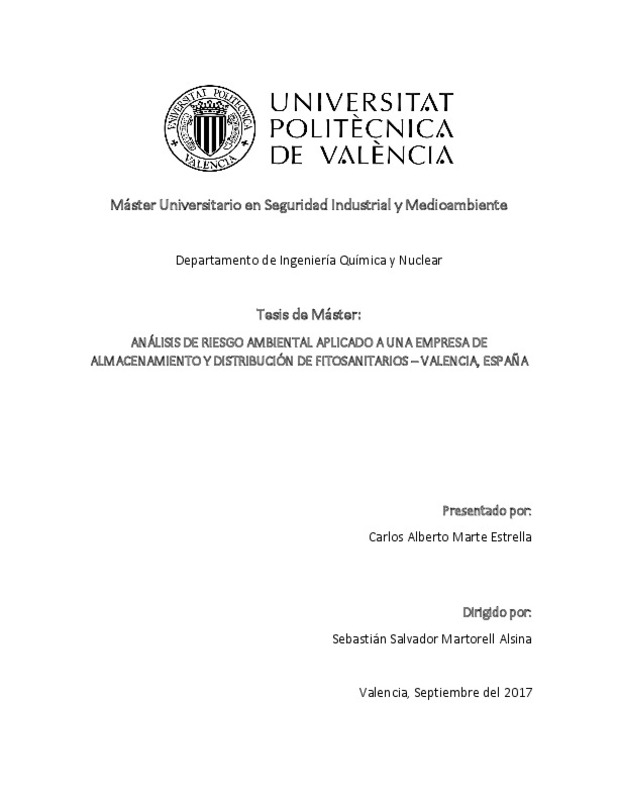|
Resumen:
|
[EN]
In this work an environmental risk analysis will be carried out, applied to a company in charge of the storage of phytosanitary products in Valencia, Spain. The objective of this thesis is to develop a risk analysis ...[+]
[EN]
In this work an environmental risk analysis will be carried out, applied to a company in charge of the storage of phytosanitary products in Valencia, Spain. The objective of this thesis is to develop a risk analysis methodology that can serve as a guide for future risk analysis, and so that the analysis can be a good decision maker, as well as good control measures, in order to have companies whose impact on the environment is minimal or sustainable. For the development of this environmental analysis, it is necessary to apply a methodology that can evaluate the effects of industrial activities on the environment. MAPFRE, in the third quarter of 2007, published an article that analyzes two fundamental factors: sources of danger and vulnerable receivers. These in turn are divided into several subfactors, which are described below, and are fundamental to quantify the environmental risk produced by the companies. First it is necessary to identify those events that may cause a possible accident, and then through analysis to determine the consequences and impacts to the environment that can cause the accident. With this information the methodology proposed by MAPFRE is applied, evaluating the sources of danger and vulnerable receptors for each existing accidental scenario. Through this methodology and the analysis of these fundamental factors, a value is obtained called Environmental Risk Index (I.C.M.). The Environmental Risk Index allows the risk assessment as a process subsequent to this analysis, where decisions can then be made, in order to reduce or eradicate the risks analyzed that generate considerable environmental damages. With the value of the ICM, together with the frequency of failure of each security system that may have the company in question, we proceed to evaluate the environmental risk, to finally estimate the level of risk that each accidental scenario can take, taking into account the existing risk levels: region of high risk, region ALARP (As low as reasonably practicable) and moderate risk region. In summary, it is expected that through the development of this work, the importance of environmental risk analysis can be noticed and companies can have a more environmentally friendly view.
[-]
El objetivo del presente trabajo es desarrollar una metodología y su aplicación al análisis de riesgo ambiental para una empresa dedicada al almacenamiento y distribución de productos fitosanitarios
Esta metodología ...[+]
El objetivo del presente trabajo es desarrollar una metodología y su aplicación al análisis de riesgo ambiental para una empresa dedicada al almacenamiento y distribución de productos fitosanitarios
Esta metodología abarca el análisis de los cuatro componentes (fuentes de riesgo, sistemas de control primario, sistema de transporte y receptores vulnerables), indicados de un modo directo y de fácil aplicación. Se basa en la evaluación de dos factores; las fuentes de peligro y los receptores vulnerables. Se divide en dos subfactores: área afectada, vulnerabilidad del entorno natural y socioeconómico.
Mediante esta metodología y el análisis de estos factores fundamentales, se obtiene un Valor ó Índice de Riesgo Medioambiental (ICM). El Valor ó Índice de Riesgo Medioambiental permite la evaluación del riesgo como proceso posterior a dicho análisis, mediante el cual se realiza una posterior toma de decisiones, en aras de reducir o erradicar los riesgos analizados que generan daños ambientales considerables.
[-]
|







